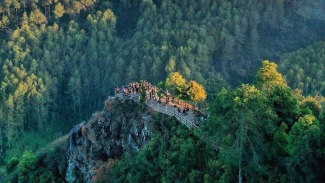Several Facts about Third Largest Desert in the World
- U-Report
VIVA – There are interesting and fun facts about the third largest desert in the world, the Sahara Desert in northern Africa. The Sahara Desert is identical as the hottest place in the world, with temperatures that can reach 50 Celsius usually.
The Sahara Desert has an area of 9,200,000 square kilometers, around the area of China and the United States, including Alaska and Hawaii. As quoted from the Live Science page, Mount Sahara is bordered by the Atlantic Ocean in the west, the Red Sea in the east, the Mediterranean Sea in the north, and the Sahel savanna in the south.
Well, besides being famous as the hottest ecozone in the world, the Sahara is also famous for its natural scenery made of sand and wind. Here are some other fun facts about the Sahara Desert.
1. The Sahara Desert Covers Most of North Africa
It's no surprise that the Sahara Desert is the third largest desert in the world after Antarctica and the Arctic. It covers most of North Africa, encompassing the countries of Morocco, Algeria, Chad, Egypt, Libya, Mali, Mauritania, Niger, Western Sahara, Sudan, and Tunisia.
2. Size and Height of the Sahara Mountain
Gurun Pasir Sahara.
- U-Report
The Sahara Desert has an area of 3.6 million square miles, the Sahara Desert is as large as China or the United States. Meanwhile, the Sahara hills can reach 180 meters in height. As information, a desert hill known as ergs shift a few yards every year, and the landscape is constantly changing.
3. Sahara Desert Residents
The Sahara is often the place of travel for Bedouin nomads (desert residents) or Beoduin people traveling on camels. The word Bedouin comes from the Arabic 'badaw' which means desert dweller.
These nomadic people moved around the desert during their migrations around North Africa and the Middle East, making tent camps near natural resources depending on the season and the needs of the people. Bedouin nomads have known for their herding traditions as well as their rich history of oral poetry.
4. The Sahara Desert Ever Reached 136 Degrees Fahrenheit
The Sahara's record high temperature is 136°F! On September 13, 1922, the Sahara's record high temperature was recorded at 136 degrees Fahrenheit in El Azizia, Libya.
5. Many Dinosaur Fossils Found in the Sahara
Ilustrasi fosil otak dinosaurus.
- U-Report
The desert is full of archaeological and paleontological wonders. Along with 6000-year-old megalithic stone circles and Saharan rock paintings, unique dinosaur fossils have been discovered by scientists.
As recently as last year, the fossilized remains of an 80-million-year-old dinosaur were discovered in a Saharan oasis. Named Mansourasaurus shahinae, this dinosaur was estimated to be 33 feet long and weighed 5.5 tons.
6. The Sahara is Actually Mostly Rocks, Not Sand
The desert consists mainly of hamada's rocky landscape. In fact, only 30 percent is sand, the remaining 70 percent is mostly gravel. The rest of the desert consists of seas of sand, rock plateaus, salt flats, arid valleys, mountains, rivers, streams, and oases.
7. Emi Koussi Volcano is the Highest Point in the Sahara with an Altitude of 3,415 meters
Emi Koussi is a shield volcano located in the Tibesti Mountains in northern Chad. The volcano has various lava domes, cinder cones, lava flows, and maars visible on its outer flanks, which are evidence of its active history.
For this time, fumaroles sit at its southern base, and hot springs heat the water to 37 degrees Celsius, perfect for a relaxing dip.
8. The Sahara was Used as a Filming Location for Star Wars
Padang pasir gurun Sahara
- saharamet.com
Several times. The Tunisian Sahara has been used as a backdrop for the cities of Tatooine (which is a real place) and Matmata, ever since the Berber desert town caught the eye of director George Lucas.
Matmata is the fictional village where Luke Skywalker grew up, and today you can still see some of the sets, often abandoned or reused in strange ways.
9. Lizards, Camels, Foxes, and Antelopes Live in the Sahara
The desert may be a difficult environment for humans to live in, but many animals live here. Camels are the main animal you'll see in the Sahara, mostly used by humans.
Some other notable wildlife species in the Sahara include the fennec fox, addax antelope, Dorcas’s antelope, and Saharan cheetah. Visitors could be lucky enough to spot one of these strange creatures during a trip to the Sahara Desert.
10. More than Twenty lakes in the Sahara
All of them are saltwater lakes, except Lake Chad, which is the only freshwater lake in the desert. There are also more than 90 oases in the Sahara. But since they are spread over 3.6 million miles, we wouldn't recommend looking for water. It might be a long walk!
11. Used to be Green Plain
It used to be lush and green, home to a variety of plants and animals. That changed approximately 5000 years ago, due to a gradual change in the earth's tilt. Experts predict that, in the future, some spots in the Sahara will return to green.
12. The Hottest Desert
Nissan Navara taklukkan medan berat Gurun Sahara
- Dok: Nissan Motor Indonesia
The Sahara is the hottest desert in the world with one of the harshest climates. The average annual temperature is 30°C, while the hottest temperature ever recorded is 58 degrees Celsius. The area receives little rainfall. In fact, half of the Sahara Desert receives less than 1 inch of rain each year.
While many consider the Sahara to be a perpetually hot climate, temperatures can drop dramatically during the day. In fact, it can reach lows of up to 6°C. This happens due to the lack of moisture in the area.
13. Earth's Axis Causes the Sahara Desert Turn into a Savanna
Every 41,000 years, the Sahara alternates between desert and savanna grassland. This is due to the wobble in the earth's axis as it rotates around the sun, which changes the location of the North African monsoon and therefore causes the Saharan landscape to undergo drastic changes.

































